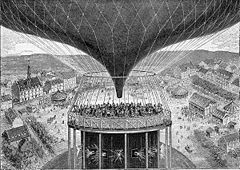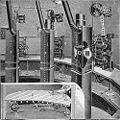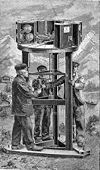- Cinéorama
-
Cinéorama was an early film experiment and amusement ride at the 1900 Paris Exposition devised by Raoul Grimoin-Sanson, that simulated a ride in a hot air balloon over Paris. It represented a union of the earlier technology of panoramic paintings and the recently invented technology of cinema.
Grimoin-Sanson began experimenting with movie cameras and projectors in 1895, and was in contact with other early researchers such as Étienne-Jules Marey. He patented the Cinéorama on 27 November 1897.
Cinéorama consisted of 10 synchronized 70 mm movie projectors, projecting onto 10 9x9 metre screens arranged in a full 360° circle around the viewing platform. The platform was a large balloon basket, capable of holding 200 viewers, with rigging, ballast, and the lower part of a huge gas bag.
The film to be shown was made by locking together 10 cameras with a single central drive, putting them in an actual balloon, and filming the flight as the balloon rose 400 metres above the Tuileries Gardens. On projecting the film, the experience was completed by showing the same film backwards, to simulate a descent. Some references describe a much longer experience, involving a trip to England, Spain, and the Sahara, but it is unclear whether the complete plan was realized.
Cinéorama lasted only three days at the Exposition. On the fourth day it was shut down by the police for safety reasons. Extreme heat from the projectors' arc lights, in the booth below the audience, had caused one workman to faint, and the authorities were worried about the possibility of a deadly fire. Cinéorama was never shown again, but a modern version, Circle-Vision 360°, was introduced at Disneyland in 1955 and continues in use today.
References
- Kenneth MacGowan (Spring 1957). "The Wide Screen of Yesterday and Tomorrow". The Quarterly of Film Radio and Television 11 (3): 217–241. doi:10.1525/fq.1957.11.3.04a00020.
- Bernard Comment (1999). The Panorama. London: Reaktion Books. p. 76. ISBN 1-86189-042-7.
- Laurent Mannoni. "Raoul Grimoin-Sanson". Who's Who of Victorian Cinema. http://www.victorian-cinema.net/grimoinsanson.htm. Retrieved 2006-06-19.
- "The Panoramas of the Paris Exposition". Scientific American Supplement (1287): 20631. 1 September 1900.
Categories:- Amusement rides
- Omnidirectional cinema
Wikimedia Foundation. 2010.



